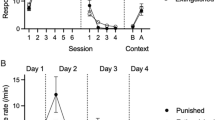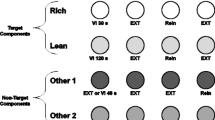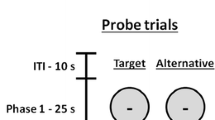Abstract
Six preschool children were placed individually in an experimental room for 10 to 14 daily 15-min sessions with a mechanical marble-dispensing clown and a toy punching bag. In each of two parts of the study, marbles were dispensed on a schedule consisting of 96-s periods of fixed-time 12-s marble delivery alternating with 96-s nonreinforcement periods (multiple fixed-time/extinction schedule). During nonreinforcement periods, five of the children hit or shook the punching bag (aggression) two to ten times more often than they did during the marble delivery periods. For four of the six children, the amount of bag punching formed a bimodal function with the least amount of responding at the very beginning, middle, and end of the nonreinforcement components. In the second part of the study, the addition of an audible discriminative stimulus during marble delivery periods for two subjects resulted in a decreased rate of responding during the first 12 s of marble delivery as compared to the rate of the children who did not have the tone stimulus. These results provide an expanded basis for the comparison of human and nonhuman extinction-induced behavior by describing the probability of human extinction-induced behavior across time and demonstrating the suppressive effects on extinction-induced responding of a stimulus correlated with reinforcement.
Similar content being viewed by others
References
AZRIN, N. H., HUTCHINSON, R. R., & HAKE, D. F. (1966). Extinction-induced aggression. Journal of the Experimental Analysis of Behavior, 9, 191–204.
BOSHKA, S. C., WEISMAN, H. M., & THOR, D. H. (1966). A technique for inducing aggression in rats utilizing morphine withdrawal. The Psychological Record, 16, 541–543.
CHEREK, D. R. (1982). Schedule-induced cigarette self-administration. Pharmacology Biochemistry and Behavior, 17, 523–527.
FALK, J. L. (1961). Production of polydipsia in normal rats by an intermittent food schedule. Science, 133, 195–196.
FALK, J. L. (1971). The nature and determinants of adjunctive behavior. Physiology and Behavior, 6, 577–588.
FALLON, J. H., Jr., ALLEN, J. D., & BUTLER, J. A. (1979). Assessment of adjunctive behaviors in humans using a stringent control procedure. Physiology and Behavior, 22, 1089–1092.
FREDERIKSEN, L. W., & PETERSON, G. L. (1974). Schedule-induced aggression in nursery school children. The Psychological Record, 24, 343–351.
FREDERIKSEN, L. W., & PETERSON, G. L. (1977). Schedule-induced aggression in humans and animals: A comparative parametric review. Aggressive Behavior, 3, 57–75.
GALLUP, G. G., Jr. (1965). Aggression in rats as a function of frustrative nonreward in a straight alley. Psychonomic Science, 11, 99–100.
HARRELL, W. A. (1972). Effects of extinction on magnitude of aggression in humans. Psychonomic Science, 29, 213–215.
HUTCHINSON, R. R. (1973). The environmental causes of aggression. In J. K. Cole & D. Jensen (Eds.), Nebraska Symposium on Motivation (pp. 155–181). Lincoln, NE: University of Nebraska Press.
HUTCHINSON, R. R. (1977). By-products of aversive control. In W. K. Honig & J. E. R. Staddon (Eds.), Handbook of operant behavior (pp. 415–431). Englewood Cliffs, NJ: Prentice-Hall.
HUTCHINSON, R. R., AZRIN, N. H., & HAKE, D. F. (1966). An automatic method for the study of aggression in squirrel monkeys. Journal of the Experimental of Behavior, 9, 233–237.
HUTCHINSON, R. R., PIERCE, G. E., EMLEY, G. S., PRONI, T. J., & SAUER, R. A. (1977). The laboratory measurement of human anger. Biobehavioral Reviews, 1, 241–259.
HUTCHINSON, R. R., & RENFREW, J. W. (1978). Functional parallels between the neural and environmental antecedents of aggression. Neuroscience and Biobehavioral Reviews, 2, 33–58.
KELLY, J. F., & HAKE, D. F. (1970). An extinction-induced increase in an aggressive response within humans. Journal of the Experimental Analysis of Behavior, 14, 153–164.
LASITER, P. S. (1979). Influence of contingent responding on schedule-induced activity in human subjects. Physiology and Behavior, 22, 239–243.
LEVITSKY, D., & COLLIER, G. (1968). Schedule-induced wheel-running. Physiology and Behavior, 3, 571–573.
LOONEY, T. A., & COHEN, P. S. (1982). Aggression induced by intermittent positive reinforcement. Neuroscience and Biobehavioral Reviews, 6, 15–37.
MULLER, P. G., CROW, R. E., & CHENEY, C. D. (1979). Schedule-induced locomotor activity in humans. Journal of the Experimental Analysis of behavior, 31, 83–90.
ONO, K. (1987). Superstitious behavior in humans. Journal of the Experimental Analysis of Behavior, 47, 261–271.
ULRICH, R., DULANEY, S., ARNETT, M., & MUELLER, K. (1973). An experimental analysis of nonhuman and human aggression. In J. F. Knutson (Ed.), The control of aggression: Implications for basic research (pp. 79–111). Chicago: Aldine.
WAGNER, G. A., & MORRIS, E. K. (1987). “Superstitious” behavior in children. The Psychological Record, 37, 471–488.
Author information
Authors and Affiliations
Additional information
This article is based on research conducted by James T. Todd in partial fulfillment of the degree of Masters of Arts at the University of Kansas. It was supported in part by a University of Kansas Biomedical Science Support Grant (4888-x706-3), by NICHHD training grant HD-02528 and by National Institute of Child Health and Human Development Training Grant HD07173. We thank Lisa M. Johnson, Linda Moreau-Pletch, Susan M. Schneider, and Steven T Higgins for their helpful comments, the teachers and staff of Edna A. Hill Child Development Lab preschools for their cooperation, Janice Pittman and Brenda K. Causey for calculating and reviewing the entire data set, and Jesus Rosales for preparation of figures.
Rights and permissions
About this article
Cite this article
Todd, J.T., Morris, E.K. & Fenza, K.M. Temporal Organization of Extinction-Induced Responding in Preschool Children. Psychol Rec 39, 117–130 (1989). https://doi.org/10.1007/BF03395056
Published:
Issue Date:
DOI: https://doi.org/10.1007/BF03395056




